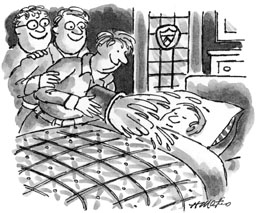September 11, 2002: From the Archives

| Read letters on this topic. |
(Illustration by Henry Martin ’48)
This fall PAW will feature excerpts from Elizabeth Greenberg ’02’s senior thesis about Princeton rituals and student traditions. Greenberg, who hopes to turn her thesis into a book, seeks further anecdotes and memories from PAW’s readers. How were you hazed when you came to Princeton? What was your view of restricted behaviors, dink wearing, and head shaving? E-mail Greenberg at eagreenb@alumni.princeton.edu or write to her c/o PAW. Click here to learn more about her project.
Hazing was a part of Princeton student life since
the earliest days of the College of New Jersey, though the practice had
multiple names and forms over the years. Sophomores taught freshmen their
place in the social hierarchy by forcing them to perform degrading acts,
awakening “newys” with cold water, head shaving, and occasional
physical abuse. Though hazing was technically forbidden by the 20th century,
the nearly identical practice of “horsing” rose in its place.
After horsing was abolished, freshmen were still subjected to extensive
restrictions on their behavior and dress, such as mandatory “dink”
wearing. Though these customs eased up during World War II, postwar classes
attempted to revive some of the traditions, resulting in “dink wars”
and a revival of head shaving. By the mid-1960s, however, freshmen hazing
fell out of popularity and practice.
![]()
Web Exclusives:
Headlines - PawPlus
- Features
Tooke's Take - Varsity
Typewriter - Inky
Dinky Do
Raising
Kate - On
the Campus - Comparative
Life - More...
PAW
Online Archives
- Print
Archives - Advertising
Info - Reader
Services
Search the Site - Contact
PAW
Princeton University
- Alumni
Links - Alumni
Council - Your
Class Secretary
